Engine and Transmission Tech
tips, technology, tools and techniques related to vehicle driveline components
|
Turbo BOP
Hi all, first post.
I have a 1979 Pinto 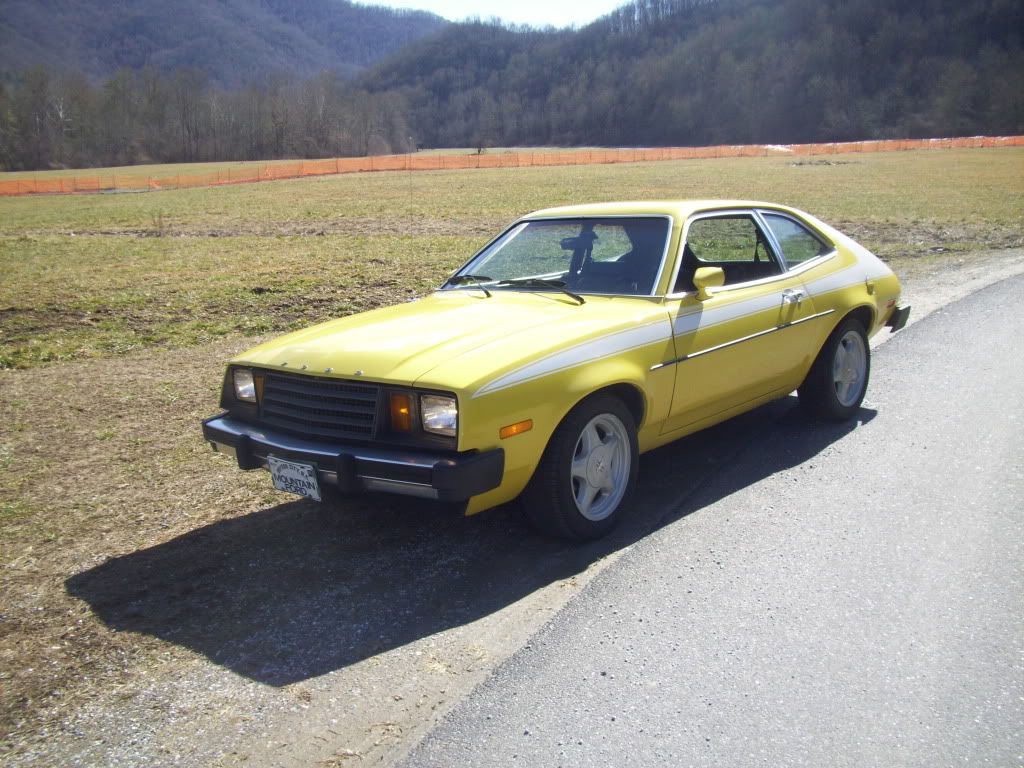
and several Rover engines(3.9 and 4.0) 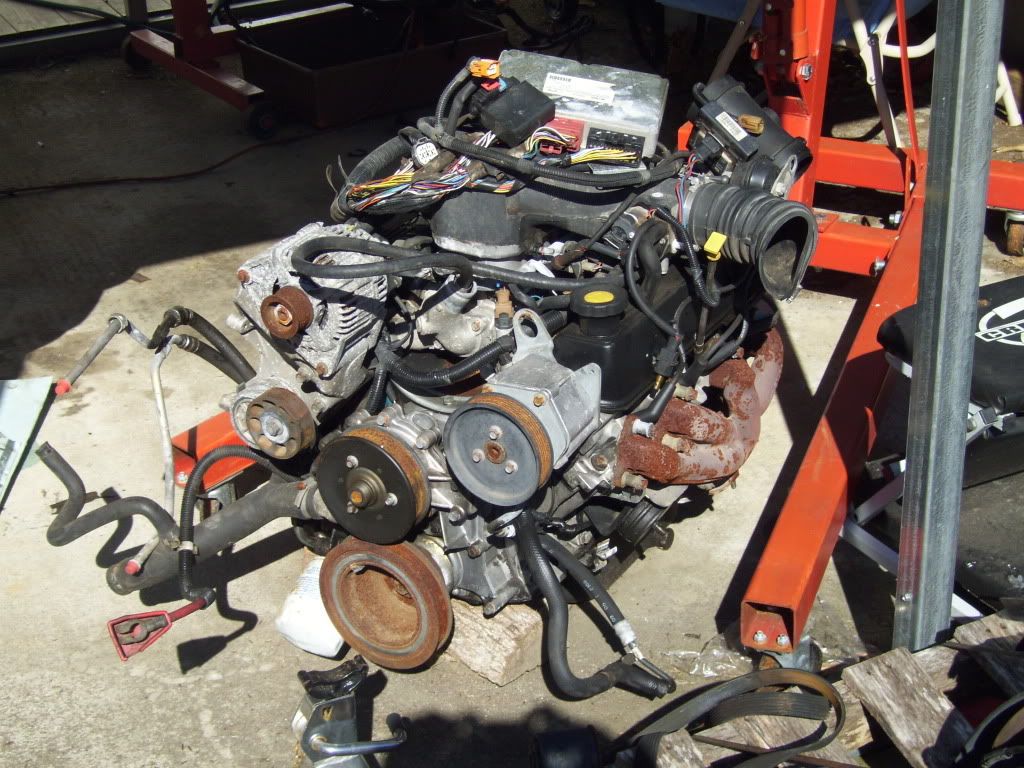
and a Cobra IRS(3.55 posi) 
My goal is 350 hp or so, but instead of an expensive high performance NA build I thought it would make sense to build the motor for torque off idle(basically stock except forged pistons and stainless exhaust valves, maybe a Stump Puller cam, low overlap)and put a turbo on it to handle the top end flow. I can stick with the 9.35 CR and go with 8 pounds boost and water/methanol injection(like Olds did), or lower the CR to 8.5 or so and go for higher boost(12-14)and intercoolers. The idea is a very small turbo for instant response and redline of 5500 or so(stock valve train and rotating assembly). I realize that a Pinto is not the normal fare on this forum, and Ford purists will sniff at me here in the States(though Ford owned much of Land Rover during the period my engines were made, so technically...), but the BOP weights nearly the same as the 2300 lump in it now(88 HP on a good day). The Pinto weights about 2500 lbs(1200 kilos)all up, can be made to handle like a go-kart and is rarely seen on the streets(all good things)and I've owned 6 of them since 1975(got two now, the other is a 1980 wagon I want to make a Pinchero out of). I have several questions. 1. Is my approach valid for what I want?(grunt when I floor it followed by boost as soon as possible) 2. Would a BMW(late model Rover)manifold produce more low end torque prior to pressurization? 3. What size turbo would I need to make sure the engine runs out of breath near the 5500 redline and start boosting just off idle.(turbo oversizing is the usual mistake people make). 4. Trumpets or flowed baseplate with none?(if Rover top used) I realize that turboing for top end is the lazy way, but it is also the cheaper way to get the HP I feel I "need"(OK, want). Thoughts? Robert Breedlove |
|
roverman Art Gertz Winchester, CA. (3188 posts) Registered: 04/24/2009 11:02AM Main British Car: 74' Jensen Healy, 79 Huff. GT 1, 74 MGB Lotus 907,2L |
Re: Turbo BOPinto
Robert, Stranger than fiction, I hope to use a PINTO raw forging crankshaft in the RV8, as a single plane. Good Luck, roverman.
|
|
BlownMGB-V8 Jim Blackwood 9406 Gunpowder Rd., Florence, KY 41042 (6470 posts) Registered: 10/23/2007 12:59PM Main British Car: 1971 MGB Blown,Injected,Intercooled Buick 340/AA80E/JagIRS |
Re: Turbo BOP
For street driving this is a fairly good plan but even better if you use an intercooler. (Most builders are after max HP) Higher compression yeilds better economy and better low rpm performance but limits usable boost.
Jim |
|
Graham B Graham Bingham Draycott, Derbyshire, UK (63 posts) Registered: 09/19/2008 08:26AM Main British Car: 1974 Triumph Spitfire Rover 3.5litre V8 |
Re: Turbo BOP
Robert,
Which Rover engine is it in your second photo above and what did it come out of? I have a 3.5 Rover in my Spitfire and I'm considering going up to a 3.9 but need it to have a distributor (I notice that in the picture your engine does not seem to have one) I thought it was only the 4.6's which had no distributor? Regards Graham B |
|
roverman Art Gertz Winchester, CA. (3188 posts) Registered: 04/24/2009 11:02AM Main British Car: 74' Jensen Healy, 79 Huff. GT 1, 74 MGB Lotus 907,2L |
Re: Turbo BOP
Robert, Before you get too deep into this engine choice, I suggest you cost-out absolutely everything needed to build a reliable, turbo RV8, including fuel system, intercooler, internal engine upgrades/etc. You may find it "less" to build a NA 350hp. sbf. If you still pick the RV8, I suggest your 4L because of 4 bolt mains, larger main and rod journals and the much improved, crank driven oil pump. Since your looking for approx. 5,500 rpm limit, the 4.6L crank would be a good choice, narrowed sbc rods and dished/forged, 305 sbc pistons, might be an option. To make 350 hp., will likely required 12+ lbs. of boost. This means smart upgrades, to make it live. Good Luck, roverman.
|
|
Re: Turbo BOP
Graham B
The engine in the photo is a cross bolted 4.0, the one in my RR Classic is an "interim" 3.9 with the crank driven oil pump and serpentine front drive, it has a distributor. It also has the four bolt main caps but they have not been drilled for the cross bolts Roverman As much as I am true blue Ford guy, the 5.0 is about 100 pounds heavier even with expensive aluminum heads(~450 vs. ~350). I have the Rovers and the one pictured has 25,000 miles on it. If I just replace the pistons(a real weakness in Rovers)with forged units and put SS exhaust valves in it, it should be reliable for a street driven engine with occasional full throttle use. Even new Chevy 6.2s and pistons aren't that expensive. Most of the time it would see little boost and the low end torque is most important. And by sizing the turbo so it runs out of breath as the engine reaches 5500 the turbo will be small enough to spool very quickly(a T3/T4 variant, most likely. They are rated at 300-350 hp). 8 pounds should get me 300 hp or so and as it is only occasional, water/methanol injection is easier, more compact and adequate for that level of boost/heat, assisting in faster spool from the initial hit(IE better street performance if not the most power). If I drop the compression ratio into the 8s somewhere then 12 lbs gets me to 350, but an intercooler would certainly be needed and there would be more lag(more piping and intercooler volume to fill)and the block and internal parts will be at their limit(without huge injections of cubic money). I also considered a 3.2 SHO for this build, but it's actually heavier than the 5.0 by about 30 lbs. 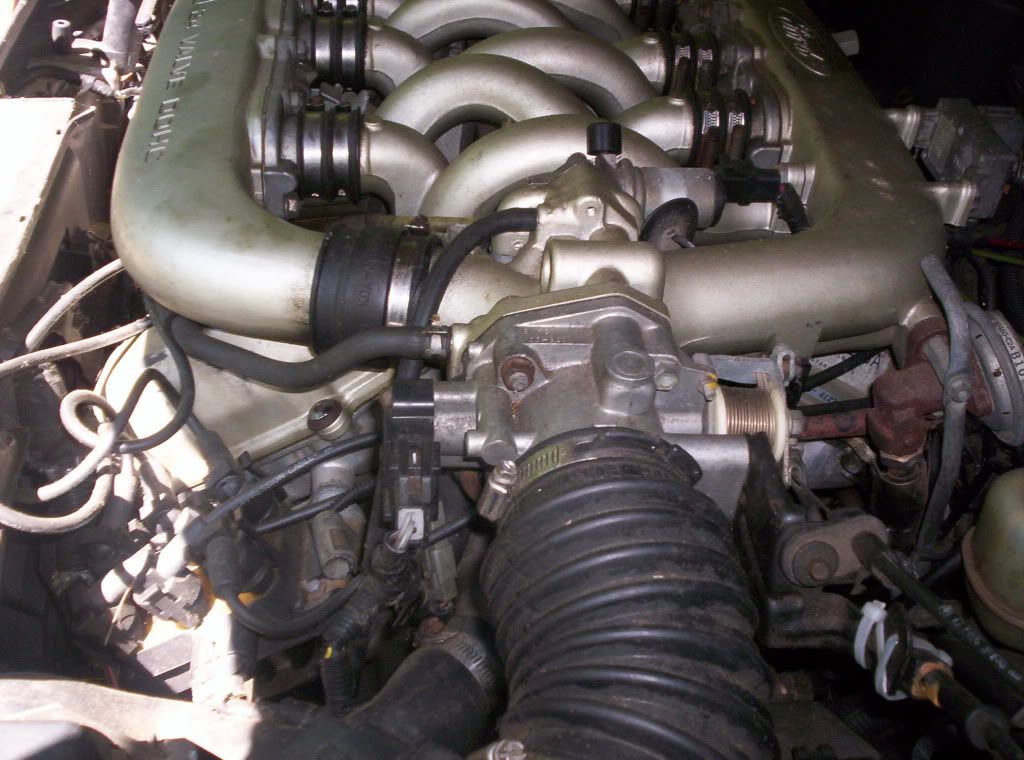 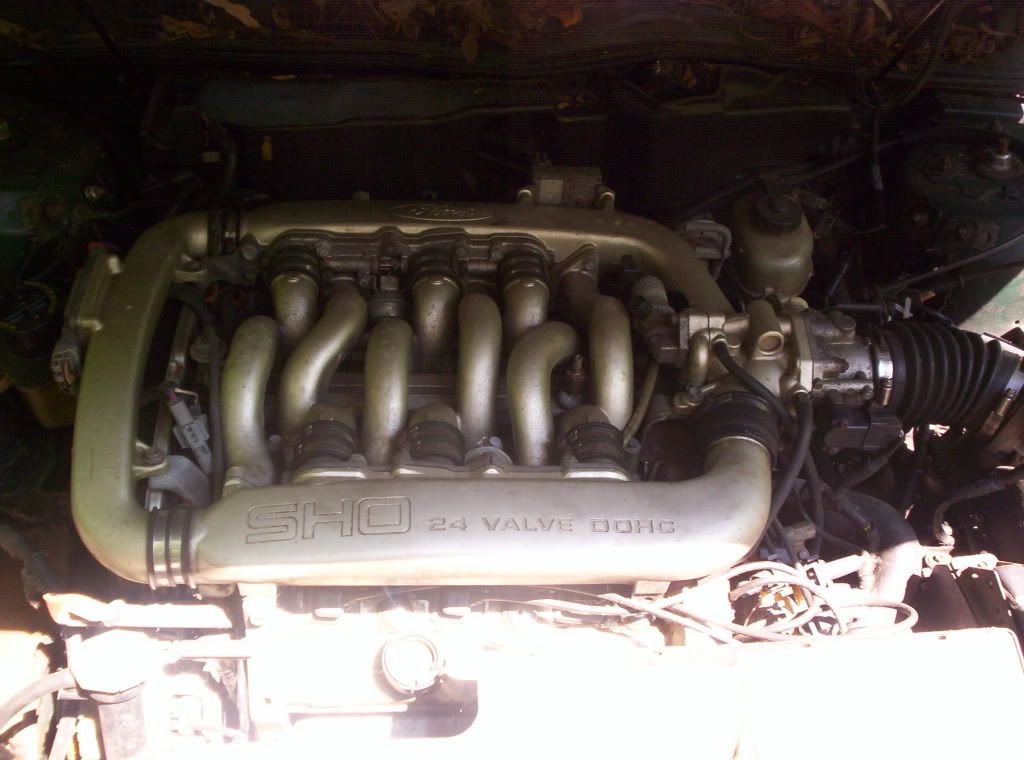
Sure is pretty, though. Stock it puts out 225, 8 lbs boost would turn it into a monster(350 or so). Forged 8.5 pistons and 12 lbs give about 440 hp(it's an 8000 rpm motor), at least according to the internet dyno posts. The Yammerhammer is a mighty beast! Weight is critical in a 2500 lb car, the weight distribution in the Pinto is pretty near perfect now and I don't want a plow, even if it is a high speed plow. Robert Breedlove |
|
minorv8 Jukka Harkola (269 posts) Registered: 04/08/2009 06:50AM Main British Car: Morris Minor Rover V8 |
Re: Turbo BOP
Here are some ideas about intake manifold: [www.mez.co.uk]
Late model Range Rover (BMW engine ) manifold will not because it is a completely different engine, but the latest Range Rover manifolds (Thor) will. Above link has some info about it. I suggest that you try to get in touch with Stevieturbo at [www.v8forum.co.uk] He ran a twin turbo 4,6 in his Ford Granada (UK model) before he swapped to a force-fed LS engine. He felt that he had reached the practical limits of the Rover engine and made a wise move to LS world. I am positive that he knows the limits of the TT Rover engine. 4,0 and 4,6 litre pistons are really nice and light years ahead of a typical Rover piston. If you donīt get greedy with boost or aggressive with the EFI programming they should last. The piston dimensions are a bit odd so you have to get custom pistons. |
|
|
|
Re: Turbo BOP
minorv8
The Thor manifold is the one I mean, it was designed by BMW for the last of the pushrod V8s( the engines in some years after that were actually Fords(4.4), so were the V8s in Jaguars(4.0, 4.2)). I understand that it makes significantly more torque off idle and is a match for the older EFI manifold stock to stock except above 5000 or so. It has much longer ram tubes though the bases are identicle. The tubular exhaust manifolds on those last Rovers would be nicer and more compact, that right side cast steel one is a mess, though the left one is not too bad. I'm not looking to stretch the limits, but to produce adequate power by less than all out effort or stress on parts. I really lean toward 9 to one compression and lower boost, this less stressful setup allows the use of very short turbo piping and water/methanol injection, with only a set of forged pistons and better exhaust valves. Shoot, 300 real HP and similar torque in a 2500 lb car is more than adequate. If Oldsmobile can get 215 HP out of a 215 with a similar setup and a carb, surely I can get 300 HP out of 244 CI and fuel injection. Roverman I read somewhere that a raw Ford 5.0 crank can be machined into a Rover, I hadn't thought of a 2.3 crank and a flat plane V8! I dearly love the sound they make through a set of crossover exhausts! They howl. I understand you can use the 2.3 turbo piston in a Rover with the right rod. It's forged, available and cheap. Wouldn't know the first thing about balancing one, do they shake? The 2.3 does, a lot! RB |
|
minorv8 Jukka Harkola (269 posts) Registered: 04/08/2009 06:50AM Main British Car: Morris Minor Rover V8 |
Re: Turbo BOP
Robert, Thor manifold has a specific lower manifold and is not interchangeable with the normal Efi manifold, You need the complete package from heads upwards. I
P38 body Range Rovers had BMW turbodiesels and later Range Rovers (L322) also had BMW 4,4 V8 engines. |
|
BlownMGB-V8 Jim Blackwood 9406 Gunpowder Rd., Florence, KY 41042 (6470 posts) Registered: 10/23/2007 12:59PM Main British Car: 1971 MGB Blown,Injected,Intercooled Buick 340/AA80E/JagIRS |
Re: Turbo BOP
Considering the engines you have available, the Rover is not a bad choice. Over here, in spite of being a Buick enthusiast, it being it is a Pinto I would look first at the 5L Ford. Despite the extra weight the overall balance should not change very much. V8 Pintos have been done and I do not think the handling was badly upset, particularly if you can set the engine back towards the firewall a bit. It's been quite a while but I seem to recall the factory even turned out a few V8 Mavericks/Pintos and those would have had iron heads. You typically see a bit of tire stagger with higher powered conversions. The extra weight can easily be accommodated with a bit less stagger, meaning slightly larger front tires than would have been used and/or perhaps a bit more front tire pressure. The 5L also has the roller cam, a significant plus.
In the 300-350 HP range you are getting close to the limits of the aluminum block in terms of thread strength, particularly for the head bolts. I was having real problems with the bolts loosening up and am convinced it was because the threads were pulling out of the block. With a cast iron block this is not a problem. I would not try to push the BOPR much over 300 hp in a street application. If I wanted more than that I would go to the iron block from the 300 Buick and perhaps the 350 Buick crank for a 5.7L displacement, run high compression, and probably forget the turbo (it also adds weight btw). But really, for the Pinto, the 302/5L is the best choice. Jim |
|
Re: Turbo BOP
BlownMGB-V8
"In the 300-350 HP range you are getting close to the limits of the aluminum block in terms of thread strength, particularly for the head bolts. I was having real problems with the bolts loosening up and am convinced it was because the threads were pulling out of the block. With a cast iron block this is not a problem" I will be replacing all the main, rod and head bolts with studs from ARP, it's cheap insurance at less than 300 dollars(less if you get them on eBay). This should be standard practice any time you rebuild the BOP, it's another weak spot. "I would not try to push the BOPR much over 300 hp in a street application. If I wanted more than that I would go to the iron block from the 300 Buick and perhaps the 350 Buick crank for a 5.7L displacement, run high compression, and probably forget the turbo (it also adds weight btw). But really, for the Pinto, the 302/5L is the best choice." I agree that my project would be close to the limit without major money infusions, but with studs, forged pistons and SS exhaust valves you have reinforced the weakest components(valve train is next, but that's going to cost you). If RPM is kept below 5500-6000 the stock crank, rods and valvetrain can handle 350. Even 5.0 blocks are limited to about 500 HP, they split in the lifter valley(or one of mine did, anyway), and better blocks(like the World Products block or SVO block)are very expensive. "being it is a Pinto I would look first at the 5L Ford." Been there-done that. As I said, in the Pinto, with the weight hanging largely in front of the front tire centerline, the 5.0 is a lump(especially if you don't want to shell out major coin for aluminum heads). It totally kills the canyon carver aspects of the car that are more important to me than absolute power or PC. I have lots of experience with the result, one of the six(74 wagon)had a 342 stroker in it with aluminum heads, but even the wagon was unbalanced and ill handling(but fast as heck in a straight line). I sold the car in disgust and vowed never again. This time I started by finding out the weight of the 4 cylinder(~325)and researching looking for a better choice. I could go with the 3.5 DOHC out of a Taurus, it's light(about 300), powerful(~200-250), etc. but it is set up for Front Wheel Drive with the waterpump on the rear of the valve cover on the left side and RWD manual transmissions rare and expensive(only those in new Mustangs with the 3.7 exist. AFAIK). The 3.4 SHO V8 has the same lack of RWD transmissions, among other problems. If I had my druthers it would be a Cosworth/Ford DFL detuned for the street, but it might as well be made of gold for what that would cost. I would put the SHO in before I would do just another 5.0 Pinto(it's so pretty). This is one in a Healy. RB |
|
roverman Art Gertz Winchester, CA. (3188 posts) Registered: 04/24/2009 11:02AM Main British Car: 74' Jensen Healy, 79 Huff. GT 1, 74 MGB Lotus 907,2L |
Re: Turbo BOP
Robert, I'm guessing you and the car, are in USA ? I haven't heard of pinto pistons in a RV8. 305 sbc pistons might work, if your sleeves are thick enough,(3.736" min). IMHO, Jim B. had head sealing problems related to thread wear,(215" head bolts wore-out the deck threads). Late RV8's, with good threads, studs and MLS head gaskets, should easily hold 12 psi/manifold boost. I don't suggest any 180deg- V8 crank for street use. Ferarri has magically made these work in 308's, and a few others, but nothing front engined-Hmmm. 180 crank with 4 into 1 headers, should sound just like the "batch of snakes"-headers.Good Luck, roverman.
|
|
BlownMGB-V8 Jim Blackwood 9406 Gunpowder Rd., Florence, KY 41042 (6470 posts) Registered: 10/23/2007 12:59PM Main British Car: 1971 MGB Blown,Injected,Intercooled Buick 340/AA80E/JagIRS |
Re: Turbo BOP
Fair enough, if the engine can't be set back you have to go with less weight or better suspension tuning. My blown Olds 215 had double helicoils (stacked) in the block with full thread engagement so I don't think thread wear was a factor and it still loosened up. But admittedly that was with 16+ psi of intercooled boost from a Roots type blower. I was pushing the limits and knew it. But I was doing what you are thinking of, using the boost to add flow at the top end, and using a stock camshaft and valves to limit max breathing so I wouldn't blow the engine, with a redline under 6 grand. It worked well. Boost came in early and strong. Very suitable for a street engine. I know the late Rover block is several pounds heavier, maybe it is a bit denser as well. One can always hope, but I don't see where studs would have made any difference in this case. And the Olds had 8 more bolts on each head than the Rover. YMMV. You'll want to be sure you don't have one of the blocks that are prone to cracks behind the liner or liner shift, both of which are expensive to repair. The Rover experts are very familiar with how to identify the good blocks, but I've forgotten. Regardless, I still feel the deck threads are the weak link in the aluminum BOPR. Valvetrain, not so much. Stiffer springs are all that's needed for 7 grand. BTDT. I've heard plenty of reports about the weak lifter valley of the SBF, you are the first I've talked to who has actually split a block though. That is one of the benefits of the Buick 300 block, it's been pushed beyond 700 hp with no such problems and has gone over 1000 with a main girdle. Back to the weight, we have a MGB-GT with a 455 BBB engine and it handles as well as a stock MGB, and should be even better after suitable swaybars are fitted. Very well balanced. We need to get updated corner weights but I'm guessing it carries an extra 200 lbs on the front tires over what the rears carry. No changes were made to the front suspension geometry. My car, with the Buick 340 and M-112 blower will as likely as not be even heavier but I'm hoping for a total weight under 2500 lbs.
Regardless, there is a lot more to making the car handle than weight distribution. (What are the figures for the stock Pinto? The V8 Maverick?) Tire size and inflation are major, and small changes in front suspension geometry can have a major impact. Anything with a 60/40 weight distribution or better can be made to handle very well. It is pretty easy to get more front tire under the car than you need to make it corner. Making those tires stick, now that is where the skill comes in. Jim |
|
Re: Turbo BOP
minorv8
"Robert, Thor manifold has a specific lower manifold and is not interchangeable with the normal Efi manifold, You need the complete package from heads upwards." I See, I've learned something I didn't know already! I thought it was just the upper, but I see now I was wrong. "P38 body Range Rovers had BMW turbodiesels and later Range Rovers (L322) also had BMW 4,4 V8 engines." But the 4.4 "BMW" was the same basic engine as the Jaguar V8, which was designed by Ford, who planned to replace the BOP motor with it before they sold their interest in Rover to BMW. It is the same basic motor as that in the last generation of the Thunderbird and in the Lincoln LS. There are detail differences but modern manufacturers trade engines a lot. Volvo got the V8 SHO for the XC90 and the Koennessegge uses a modified version as well. RB |
|
Re: Turbo BOP
Roverman
The 2.3 has a standard bore of 3.78 inches(96.01 mm). That would require new liners, I guess. Could the pistons be turned down?(never mind, stupid question) Wiseco has K487M94-1.22 comp ht., -20cc dish in 3.7(94mm) to K484M94-1.22 Comp Ht. and -6cc dish that might work, they are from the mod motor V8. The BMW S14B23 2.3 turbo pistons are also 94 mm in 42mm(1.65)comp ht. Rods and pins can be worked out. RB |
|
|
|
Re: Turbo BOP
blownmgbv8
"I don't see where studs would have made any difference in this case." Studs move the clamping forces from the threads of a bolt going into the soft block to the top threads of the hard stud. It makes a heck of a difference in keeping the threads in the block undamaged as they are fully engaged and in their final position BEFORE any torque is applied. Studs are at least a third stronger than bolts in tension(ARPs are almost twice as strong). They also eliminate wear and spalling on the block threads in motors that are disassembled often. That's why the first time a BOP is disassembled all of the main bolts(rods(at least ARP rod bolts), mains and head bolts)should be replaced with studs, it is a permanent fix and makes your assembly stronger. This is especially important on any two bolt main blocks with the small registers(pre 3.9 interim), fretting(moving around under load)is inevitable on these blocks otherwise, leading to crank failure or damage. "You'll want to be sure you don't have one of the blocks that are prone to cracks behind the liner or liner shift, both of which are expensive to repair. The Rover experts are very familiar with how to identify the good blocks, but I've forgotten" The 4.6s with a red mark in the lifter valley are the strongest blocks, but any of the four bolt main blocks should be good(pressure test the cooling system before spending money on any block). Even cracked blocks can be fixed with the top-hat liners, but it's not cheap. But 96 mm liners cost no more than the 94 mm ones to install and this opens a flood gate in piston choices. "Back to the weight, we have a MGB-GT with a 455 BBB engine and it handles as well as a stock MGB, and should be even better after suitable swaybars are fitted. Very well balanced. We need to get updated corner weights but I'm guessing it carries an extra 200 lbs on the front tires over what the rears carry." Look at the side view of the MG. 
It is technically a mid engine car as the vast majority of that motor is behind the centerline of the front wheels. Now look at the side view of the Pinto, notice how the centerline of the front wheels is somewhere around the third and fourth cylinder from the front of a V8(Audis are bad for this as well). The overhang of the mass means that, all else being equal, a hundred pounds on the engine has much more effect on the Pinto's f/r balance than a hundred pounds on the MG engine. 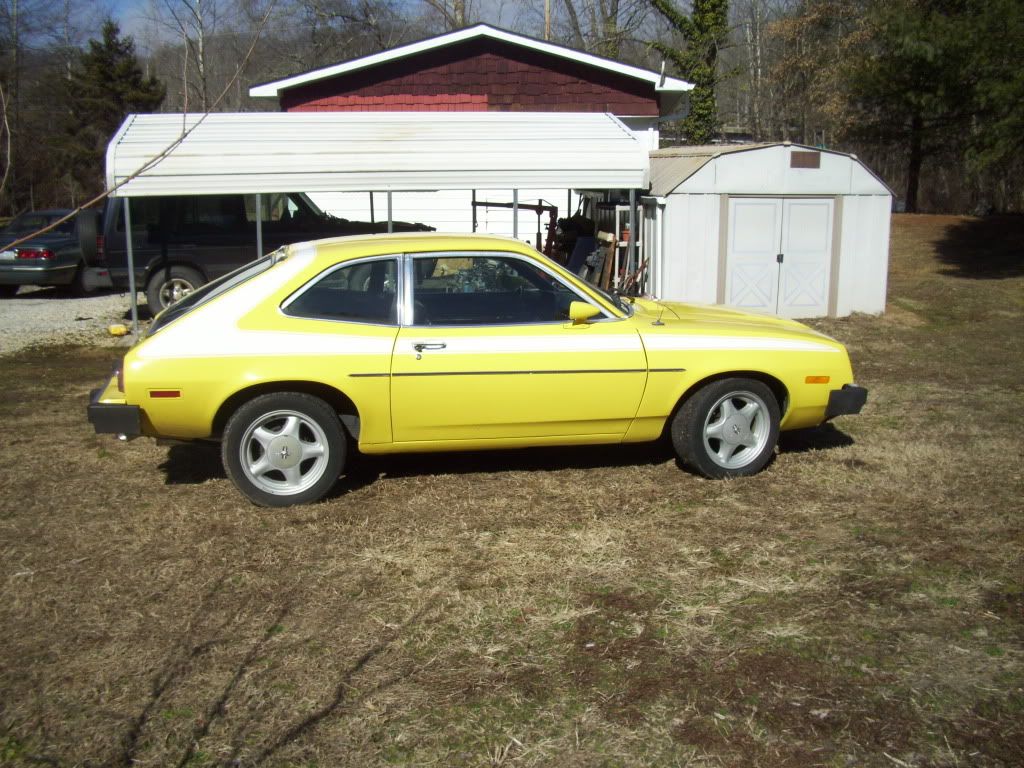
Two hundred extra pounds on the engine of a Pinto means high speed plow unless you also put 200 pounds behind the rear axle, defeating the Lotus principle("add lightness"). Right now the Pinto is ~52/48. Add almost 10% of the total car weight(as a 5.0 would do even with aluminum heads)and the front will have more than 60% on the front wheels, not good(well...it's good for drag racing). Replacing the current 2.3 with the Rover will actually improve that balance a little(2.3 bare engine 325#, Rover 315#). The IRS adds about 100 lbs to the rear so a little gain is OK, but 50/50 should be the goal for a canyon carver. Or that's my thinking, anyway. RB |
|
Re: Turbo BOP
That is one of the benefits of the Buick 300 block, it's been pushed beyond 700 hp with no such problems and has gone over 1000 with a main girdle.
IIRC, that was actually a Buick 350 block that went +1000. You would hope that the shorter deck 300 would be stronger ... but that's not really something you can guarantee without real world testing. There may have been fairly significant casting design changes that affected the power handling of the 300 block that were corrected in the foundry when Buick converted to all 350 production that no one has really run into yet. Early cast iron ( v6 and small block ) power builds for Buicks are far and few between. I do like your thinking though. Edited 1 time(s). Last edit at 01/18/2013 05:18PM by Todd McCreary. |
|
roverman Art Gertz Winchester, CA. (3188 posts) Registered: 04/24/2009 11:02AM Main British Car: 74' Jensen Healy, 79 Huff. GT 1, 74 MGB Lotus 907,2L |
Re: Turbo BOP, mid-engine ?
There you have it, you need a transverse/mid-engine, RV8 powered Pinto ! Be the first one on planet earth. Toyota MR 2 turbo 5 speed t-axle, is a good value. Cheers, roverman.
|
|
Re: Turbo BOP
Roverman
How 'bout this... 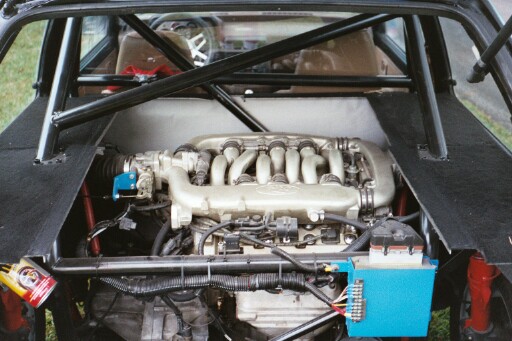
[www.jaylenosgarage.com] I just love that SHO motor, too bad it's so heavy. RB |
Sorry, only registered users may post in this forum.



